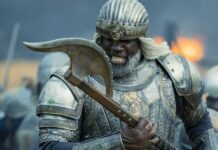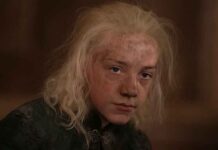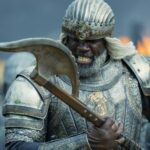To give it some context,the cast were unequivocal in both their pleasure and pain after filming the long sequence.
“It was the most unpleasant experience I’ve had on Thrones,” actor Iain Glen, who plays Ser Jorah Mormont, said. Glen’s co-star Maisie Williams, who plays Arya Stark, summed it up thus: “There are moments you’re just broken as a human and just want to cry.”
Sneak peek: Daenerys Targaryen (Emilia Clarke) and Jon Snow (Kit Harington) on the eve of war.Credit:Helen Sloan/HBO
The battle sequence is a pivotal piece of the final, six-episode season of Game of Thrones, and is already anticipated to be the most important episode in the show’s almost decade-long history.
The clash – between the army formed by the Houses of Westeros and the army of the Night King, and his undead White Walkers – edges past the previous record held by the battle of Helm’s Deep in The Lord of the Rings: The Two Towers, which ran for just under 40 minutes.
To make it happen, Game of Thrones showrunners David Benioff and Dan Weiss needed the very specific talents of director Miguel Sapochnik, who’d previously directed the show’s most action-oriented episodes, season five’s Hardhome and season six’s Battle of the Bastards.
Sneak peek: Jaime Lannister (Nikolaj Coster-Waldau) and Brienne of Tarth (Gwendoline Christie) in battle.Credit:Helen Sloan/HBO
The battle sequence in Hardhome, in which an army of undead wights defeated the city of Hardhome, forcing Jon Snow (Kit Harington) and others to flee, took a month to film at the Magheramorne quarry in Northern Ireland.
Like Hardhome, Battle of the Bastards is also considered one of the series’ best episodes, in which Jon Snow and Ramsay Bolton (Iwan Rheon) face off in a battle for control of Winterfell, a clash which nearly goes to Bolton until the arrival of Sansa Stark (Sophie Turner), Petyr Baelish (Aidan Gillen) and the knights of the Vale.
The Battle of Winterfell, by all accounts, will best both episodes.
In film production it would be usual to split such a long sequence into “units” with first, second and sometimes third units filming material concurrently. But in a break with that custom, Sapochnik put a case to Benioff and Weiss to film the entire battle in a single, three-month shoot.
Loading
“We built this massive new part of Winterfell and originally thought, ‘We’ll film this part here and this part there,’ and basically broke it down into so many pieces it would be shot like a Marvel movie, with never any flow or improvisation,” Sapochnik says.
Instead, he wanted to commit the production to 11 weeks of brutal night filming. “I said, ‘If we don’t, we’re going to lose what makes Game of Thrones cool and that is that it feels real,'” Sapochnik says.
The resulting shoot was nicknamed “The Long Night” by the show’s cast and production crew.
“When you have rapid cutting you can tell it was all assembled in post-production,” Benioff says. “That’s not the show’s style and it’s not Miguel’s style.”
Harington, who featured centrally in both Hardhome and Battle of the Bastards, will by all accounts play a central part of the coming Battle of Winterfell.
Kit Harington as Jon Snow, front, in a scene from Game of Thrones.Credit:HBO
“Dan Weiss has admitted to me that writing the battle sequences, to [he and Benioff], is the hardest thing,” Harington says. “They love writing scenes between characters, but the battle sequences, they have to hand it over with a lot of trust to the director and the actors and the crew.
“I think that’s where Miguel’s been brilliant [because] on paper those battle sequences can be quite difficult to read,” Harington says. “It is in the doing of them that you figure things out, and David and Dan were great to give us license. I think that’s what made them great in the end.”
THE WEAPONS OF WAR
Longclaw, wielded by Jon Snow on Game of Thrones.Credit:Helen Sloan/HBO
Almost every aspect of the making of Game of Thrones will survive in the form of a permanent exhibition of costumes and props, but few props on the show are as revered by fans as the iconic weapons wielded by the show’s key characters.
They include Longclaw, the sword wielded by Jon Snow which was a gift from Lord Commander Mormont, Heartsbane, the family heirloom sword gifted by Samwell Tarly to Jorah Mormont and Widow’s Wail and Oathkeeper, the two swords forged from ice and made with Valyrian steel, the first wielded by Jaime Lannister and the second by Brienne of Tarth.
While many shows source props from external agencies, Game of Thrones has the singular distinction of an on-set foundry which is part of the vast behind-the-scenes operation run by the show’s Australian armourer Natalia Lee.
For each weapon, a full version is made, in addition to a rubber version and a safety version, depending on the type of scene. The safety versions are typically worn, unless close combat requires the rubber version (for the actor’s safety) or, for close-up detail, the real version.
“We have some that would be blunted but we still have to be very safety-conscious about them for close-ups,” Lee says. “And for action sequences we’ll have all different situations … for instance, we might have an axe that hits a stuntman’s head 20 times in a day so we’ll have a different grade of softness to help.”
However, the softer weapons do lack the heft required to look believable in some scenes, Lee says. “Sometimes the director will say, that actually looks like it’s very light, and we might have to go and get a heavy version.”
Every key weapon on the show is handmade and then Lee and the show’s stunt coordinators train the actors in their use.
The foundry tackles every scale of order, whether it is a weapon for a single wielder, as many of the iconic weapons of Westeros are, or indeed when weapons and armour need to be mass-produced for large-scale battle sequences.
“We might have a generic army that we replicate, for instance, [elite warrior-eunuchs] The Unsullied needed 400 sets of shields and spears,” Lee says. “We might streamline that process and do more generic weapons but there are a handful each year that are principal actors’ that are absolutely custom-made.”
The final season of Game of Thrones airs Mondays at 11am on Foxtel.
Michael Idato is entertainment editor-at-large of The Sydney Morning Herald and The Age.
Most Viewed in Entertainment
Loading




















![[Book Review] The Blade Itself (The First Law Trilogy) by Joe Abercrombie](https://bendthekneegot.com/wp-content/uploads/2018/01/1516047103_maxresdefault-218x150.jpg)
















